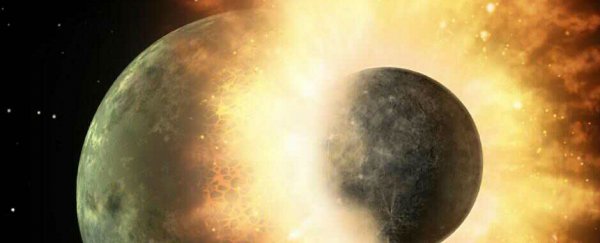Earth is believed to have formed about 4.6 billion years ago, growing in size as a result of frequent collisions with asteroids. These collisions are thought to have initially happened at slow speeds, and became progressively faster as the planet grew in size. One especially large impact is thought to be responsible for the formation of our Moon.
Now, a team of researchers at the Lawrence Livermore National Laboratory (LLNL) in the US has shown that these violent asteroid collisions would have generated significant amounts of iron vapour - and that this metal mist would have formed at much slower impact speeds than previously thought.
The results, which were published in Nature Geoscience, could prompt a rethink of how planets form, and suggest the Earth's core might have started forming earlier than we think.
"This causes a shift in how we think about processes like the formation of Earth's iron core," said geophysicist Richard Kraus in a press release. "Rather than the iron in the colliding objects sinking down directly to the Earth's growing core, the iron is vaporised and spread over the surface within a vapor plume. After cooling, the vapor would have condensed into an iron rain that mixed into the Earth's still-molten mantle.
"The timing of Earth's core formation can only be determined via chemical signatures in Earth's mantle, a technique that requires assumptions about how well the iron is mixed. This new information actually changes our estimates for the timing of when Earth's core was formed," Kraus added.
But the findings could also hold an important clue about why the chemical composition of the Earth and Moon are different, despite the latter essentially being a chip off the block, so to speak.
"The chemical difference between Earth and the moon has been perplexing, and casts a shadow over the prevalent idea that the Moon formed from the same stuff as Earth," writes geoscientist Simon Redfern from the University of Cambridge for The Conversation.
Redfern writes that the new finding "suggests that the iron mist thrown up from the high velocity impacts… travelled fast enough to escape the Moon's gravity, but stayed gravitationally stuck on more massive Earth… Earth would therefore have captured the metal cores of colliding asteroids, while the Moon will have failed to."
So how exactly did the researchers manage to simulate high-energy asteroid collisions? Well they used the Sandia National Laboratory's Z-Machine, which, in the photo below, looks kind of like the coolest, most hazardous thing we've ever seen.
 The Sandia Z Machine was used to simulate the asteroid impacts. Credit: Randy Montoya
The Sandia Z Machine was used to simulate the asteroid impacts. Credit: Randy Montoya
Redfern describes it for The Conversation as: "huge electromagnetic gun – twice as powerful as the world's total generating capacity – that can launch projectiles into iron targets at ultra-high velocity." In other words, don't stand too close.
According the LLNL release, the team "developed a new shock-wave technique to measure an important material property — the entropy gain during shock compression". This allowed the team to determined the critical impact conditions needed to vaporise the iron within colliding asteroids.
"The results could imply that models for estimating the time scales of Earth's core formation could be out by as much as a factor of ten, with the core forming much earlier in Earth's history than previously recognised," writes Redfern.
Source: The Conversation
